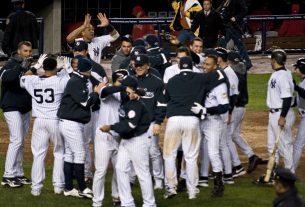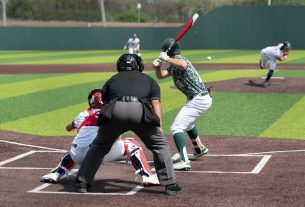When a runner is forced to advance and tagged out, a force out occurs. A tag out happens when a fielder tags a runner with the ball.
A runner’s status is determined by force outs and tag outs in baseball. In a force out, a runner is compelled to advance because the batter has become a runner, resulting in an out.
In contrast, tag outs require the defensive player to physically tag the runner. Both plays are integral to game strategy and can shift the momentum of an inning. By understanding these plays, one can gain a deeper understanding of baseball. Both new and seasoned fans need this knowledge.
Baseball Force Out

Baseball is a game filled with exciting moments and strategic plays. Two crucial defensive tactics are the Force Out and Tag Out. Understanding these can enhance the viewing experience. We’ll explore Baseball Force Outs, explaining their definitions and providing gameplay examples.
Definition
Runners are forced to advance to the next base when a batter becomes a runner. The defense can record an out by touching the base before the runner arrives. It is easier for the defense because it does not require direct tagging.
Consider these key points for a Baseball Force Out:
- The runner must advance due to the batter becoming a runner.
- The defense touches the base with the ball before the runner arrives.
- No need to tag the runner directly.
Here is a simple table highlighting the differences between Force Out and Tag Out:
| Force Out | Tag Out |
| Runner must advance | Runner can stay |
| Defense touches base | Defense tags runner |
| Occurs frequently | Occurs less often |
In summary, a Force Out is a defensive strategy. By touching the base before the runner reaches it, it is easier than a tag out.
Examples In Gameplay
There are many Force Outs during a game, especially when there are multiple runners on base. Let’s explore some scenarios:
- Bases Loaded: The batter hits a ground ball. The fielders can throw to home plate for a force out, preventing a run.
- Double Play: With a runner on first, a ground ball is hit to the shortstop. The shortstop throws to second base for a force out. The second baseman then throws to first base for another force out, completing a double play.
Let’s look at a real-game example:
Situation: Runners on first and second, one out.
- The batter hits a ground ball to the third baseman.
- The third baseman quickly steps on third base for a force out.
- He then throws to second base for another force out, completing a double play.
In these scenarios, the Force Out play is crucial. It can prevent runs and end innings effectively. The defense must act quickly and precisely, making these plays an exciting part of baseball.
Baseball Tag Out

Baseball is a game rich with rules and strategies. Tag outs and force outs are two key defensive plays. Both are crucial for getting runners out and changing the momentum of the game. Tag outs are interesting because a defensive player has to physically touch the runner. This blog post will explore the concept of a tag out in baseball.
Definition
Runners are tagged out when a fielder touches them with the ball or glove. Runners must not be on bases when this happens. When a runner is trying to advance to the next base, the tag out is a fundamental way to get them out.
Here are some key points about tag outs:
- Physical contact: The fielder must touch the runner with the ball.
- Runner’s position: The runner must be off the base.
- Ball control: The fielder must have control of the ball when making the tag.
Unlike a force out, a tag out can occur anywhere. A tag opportunity depends on the runner’s position. As an example, a runner caught in a rundown between bases must be tagged out.
A tag out rule creates excitement and complexity. Fielders must be accurate and fast. A runner must be aware of his surroundings and the fielder’s location.
Examples In Gameplay
Tag outs can occur in various game situations. Here are some common scenarios:
- Pickoff attempts: A pitcher throws to a base to catch a runner off guard. If the fielder tags the runner before they return to the base, it’s a tag out.
- Rundowns: When a runner is caught between bases, fielders throw the ball back and forth. The goal is to tag the runner before they reach a base.
- Stealing bases: A runner tries to steal a base. The catcher throws to the fielder at the base. If the fielder tags the runner before they reach the base, it’s a tag out.
Here’s a table summarizing these scenarios:
| Scenario | Description |
| Pickoff Attempt | Pitcher throws to a base; fielder tags the runner. |
| Rundown | Fielders throw the ball back and forth to tag the runner. |
| Stealing Base | Catcher throws to the base; fielder tags the runner. |
Tag outs are thrilling to watch. They often occur in high-pressure moments. Fielders must act quickly and accurately. Runners must be strategic and fast. Baseball’s dynamic makes it exciting to watch.
Key Differences
Force outs and tag outs are crucial differences in baseball that both players and fans should understand. The outcome of these two defensive plays can be significantly affected. Let’s dive into the main distinctions that set them apart.
Fielding Techniques
The method of fielding a force out differs from that of a tag out. In a force out, the fielder must touch the base before the runner arrives. Here’s a breakdown of the techniques for each:
- Force Out:
- The fielder needs to step on the base with possession of the ball.
- This action can be quick, often requiring precise footwork.
- Fielders usually throw the ball to a teammate already positioned on the base.
- Tag Out:
- The fielder must physically touch the runner with the ball or glove.
- This technique demands close pursuit and quick reflexes.
- Tag outs often occur during rundown plays or stolen base attempts.
Here’s a simple table summarizing the fielding techniques:
| Play Type | Action Required | Common Situations |
| Force Out | Touch the base | Ground balls, double plays |
| Tag Out | Tag the runner | Rundowns, stealing bases |
Game Situations
Force outs and tag outs are used depending on the situation. A play can change the course of an inning. Here are some typical scenarios:
- Force Out:
- Occurs when runners are forced to advance to the next base.
- Common in double play attempts, where multiple runners are involved.
- Happens frequently with bases loaded or runners on first and second.
- Tag Out:
- Occurs when the runner is not forced to advance.
- Typically seen during stolen base attempts.
- Happens during pick-off moves when the pitcher tries to catch the runner off the base.
Let’s summarize these situations in a simple table:
| Play Type | Situation | Example |
| Force Out | Runners forced to advance | Bases loaded, double play |
| Tag Out | Runner not forced to advance | Stolen base attempt, pick-off |
Understanding these key differences helps players make the right decisions on the field, ensuring they capitalize on every defensive opportunity.
Umpire’s Role
Baseball is a game of strategy and precision. Often, the outcome of a game depends on the force out and tag out. The umpire’s role is crucial in judging these plays accurately. Their decisions can make or break a team’s chances of winning. Let’s explore how umpires judge force outs and tag outs on the field.
Judging Force Out
When a batter becomes a runner, the runner must advance to the next base. The umpire must watch the ball and the runner’s foot simultaneously. This requires incredible focus and quick decision-making.
Key Points Umpires Consider for Force Outs:
- The fielder must have control of the ball.
- The fielder’s foot must be touching the base before the runner arrives.
- Umpires listen for the ball hitting the glove and watch for the runner’s foot touching the base.
Umpires position themselves for the best view. They need to see the fielder’s foot and the runner’s foot clearly. A consistent call is crucial to fair play. In making decisions, umpires use visual and auditory cues.
Here’s a simple table to outline the key aspects:
| Aspect | Details |
| Control of the Ball | Fielder must have the ball securely |
| Foot on Base | Fielder’s foot must be on the base |
| Runner’s Position | Runner’s foot must not touch the base first |
Judging Tag Out
The fielder must tag the runner with the ball before he reaches the base. Fast movements are often required for this type of out. The umpire’s role is to ensure the tag is applied correctly.
Key Points Umpires Consider for Tag Outs:
- The fielder must have the ball in hand or glove during the tag.
- The tag must be applied before the runner touches the base or home plate.
- Umpires must see the contact between the fielder and the runner.
Umpires must position themselves clearly to see tags. They watch the fielder’s glove or hand and the runner’s body. Umpires often make split-second decisions because timing is crucial.
Here’s a breakdown of what umpires look for:
| Aspect | Details |
| Ball Control | Fielder must have the ball securely |
| Tag Timing | Tag must be before the runner reaches the base |
| Tag Contact | Clear contact between the fielder and the runner |
Both force outs and tag outs require umpires to be vigilant and precise. Their judgment ensures the game is fair and exciting.
Strategy And Tactics
Force Out vs Tag Out involves understanding the key differences and strategies behind these two defensive plays. Stopping base runners and getting them out requires both plays. It is important to use each tactic effectively if you want to excel in baseball.
When To Use Force Out
In force outs, runners advance because they become runners due to the batter’s actions. This tactic is often used by infielders to make quick outs. Here are some key points to consider:
- Bases Loaded: With runners on all bases, infielders can throw to home plate to force out the runner coming from third base.
- Double Play Opportunity: If there is a runner on first base, infielders can attempt a double play by getting the force out at second base and then throwing to first.
- Speed of the Play: Force outs are quicker and don’t require tagging the runner.
Using force outs effectively requires quick decisions and precise throws. Using this table, you can determine when force outs are beneficial:
| Scenario | Action |
| Runners on First and Second | Throw to Third for Force Out |
| Runner on First | Throw to Second for Force Out |
| Bases Loaded | Throw to Home for Force Out |
When To Use Tag Out
A tag out requires the fielder to tag the runner with the ball. This play is often used when force outs are not possible. Here are some scenarios where tag outs are ideal:
- Rundowns: When a runner is caught between bases, fielders can chase and tag the runner.
- No Force Situation: If there are runners on second and third, and the ball is hit to the infield, fielders must tag the runner.
- Pickoff Attempts: Pitchers or catchers can tag out runners attempting to steal a base.
Tag outs require good coordination and quick reflexes. Here’s a breakdown of common situations for tag outs:
| Scenario | Action |
| Runner caught between bases | Chase and tag the runner |
| Runner stealing a base | Tag out by catcher or infielder |
| Runners on second and third, ball hit to infield | Tag the runner advancing to third |
Mastering both force outs and tag outs is crucial for any baseball player. By understanding these strategies, players can make better decisions and improve their defensive skills on the field.
Player Perspectives
The game of baseball requires quick decision-making and strategy. Understanding the difference between a force out and a tag out is crucial for players. Both plays aim to get the runner out, but require different skills and mindsets. A player’s game approach and training routine can be affected by these plays.
Preference And Specialization
According to their position and role on the field, players often prefer force outs or tag outs. Shortstops and second basemen are frequently involved in force outs. When throwing to the next base, these players must be quick and precise.
Often, outfielders and catchers are specialized in tag outs. They must throw accurate throws and tag quickly. A player’s strengths and game situation determine which play to execute.
Key Preferences:
- Infielders: Prefer force outs for quick double plays.
- Outfielders: Focus on tag outs when throwing to home plate.
- Catchers: Master tag outs to prevent runs.
Specialization helps players succeed. Infielders practice quick throws and footwork, while outfielders and catchers practice accuracy and tagging. Defensive strategies can be improved by understanding these preferences.
Training And Skill Development
Training for force outs and tag outs involves different drills and focuses. The infield practices quick throws and double plays. They need to anticipate the ball’s path and react swiftly. Among the drills are fielding ground balls, pivoting quickly, and throwing accurately.
Catchers and outfielders focus on arm strength. They practice long throws and quick tags. Their drills include throwing to home plate, simulating game scenarios, and practicing hand-eye coordination.
Training Drills:
| Player Position | Training Focus | Key Drills |
| Infielders | Quick throws, footwork | Ground ball fielding, double play turns |
| Outfielders | Arm strength, accuracy | Long throws, tagging practice |
| Catchers | Tagging precision, hand-eye coordination | Throwing to bases, game scenario simulations |
Training develops the skills needed for force outs and tag outs. Coaches should tailor drills to players’ strengths. By doing so, players are prepared for any defensive situation.
Conclusion
It’s crucial for baseball fans and players to know the difference between a force out and a tag out. A game’s outcome can be affected by these rules. Having a sense of when and how each play occurs enhances your understanding.
Keep these insights in mind next time you watch or play baseball.
Read More
What Does Tagging Up Mean In Baseball?
What Does Defect Mean In Baseball?



